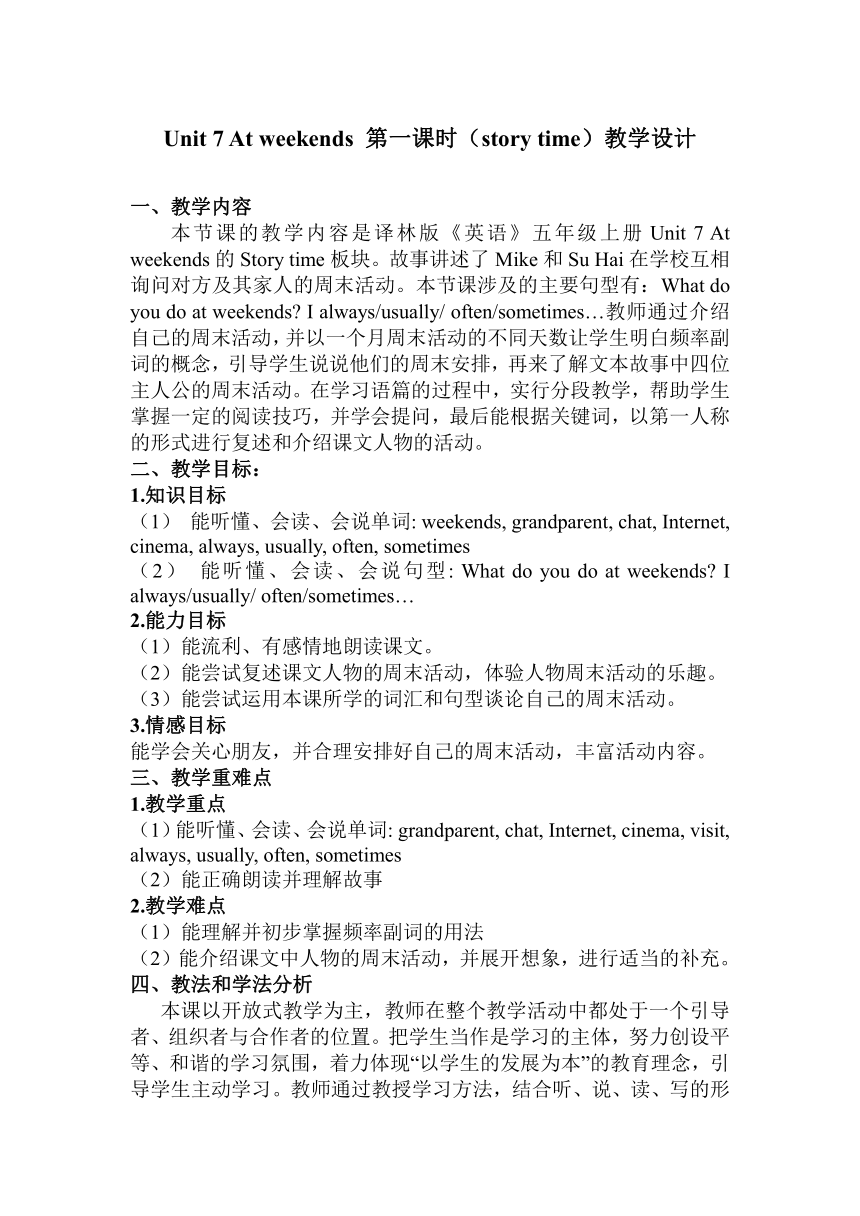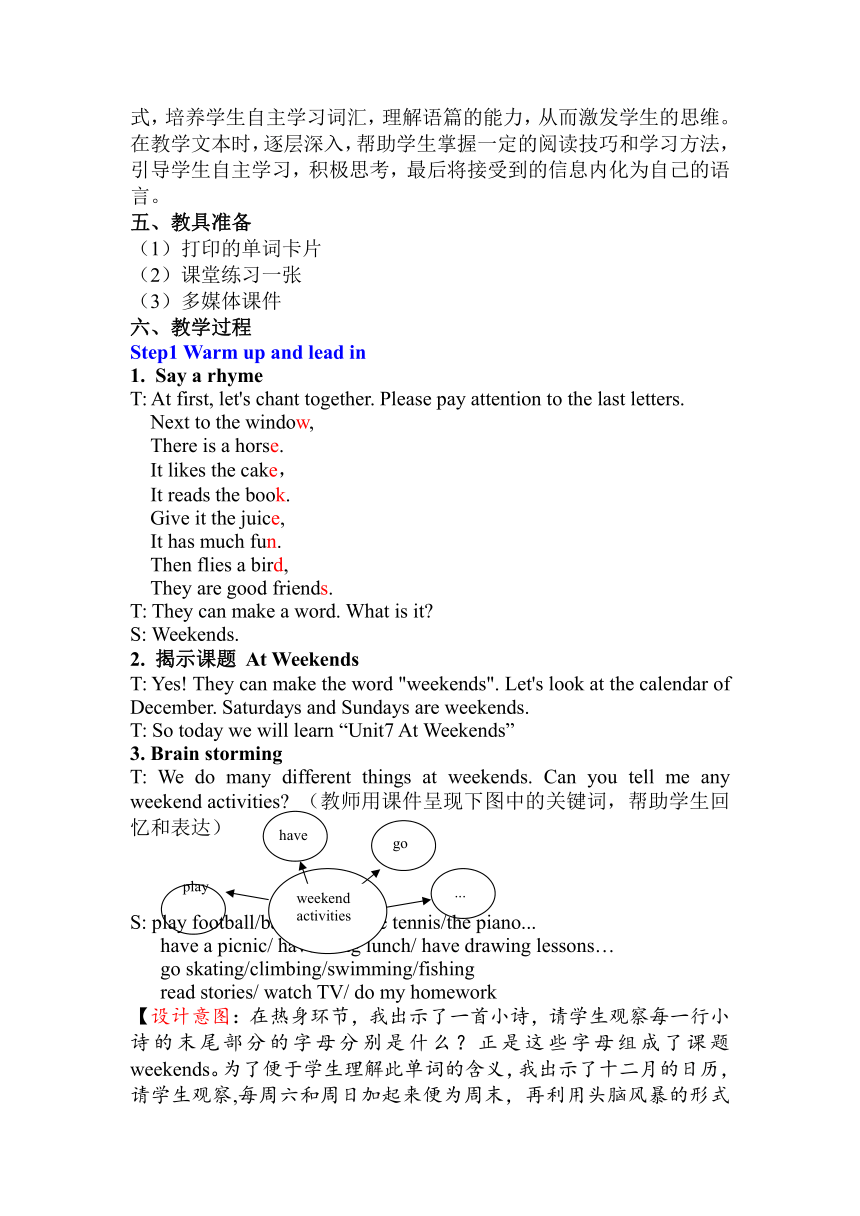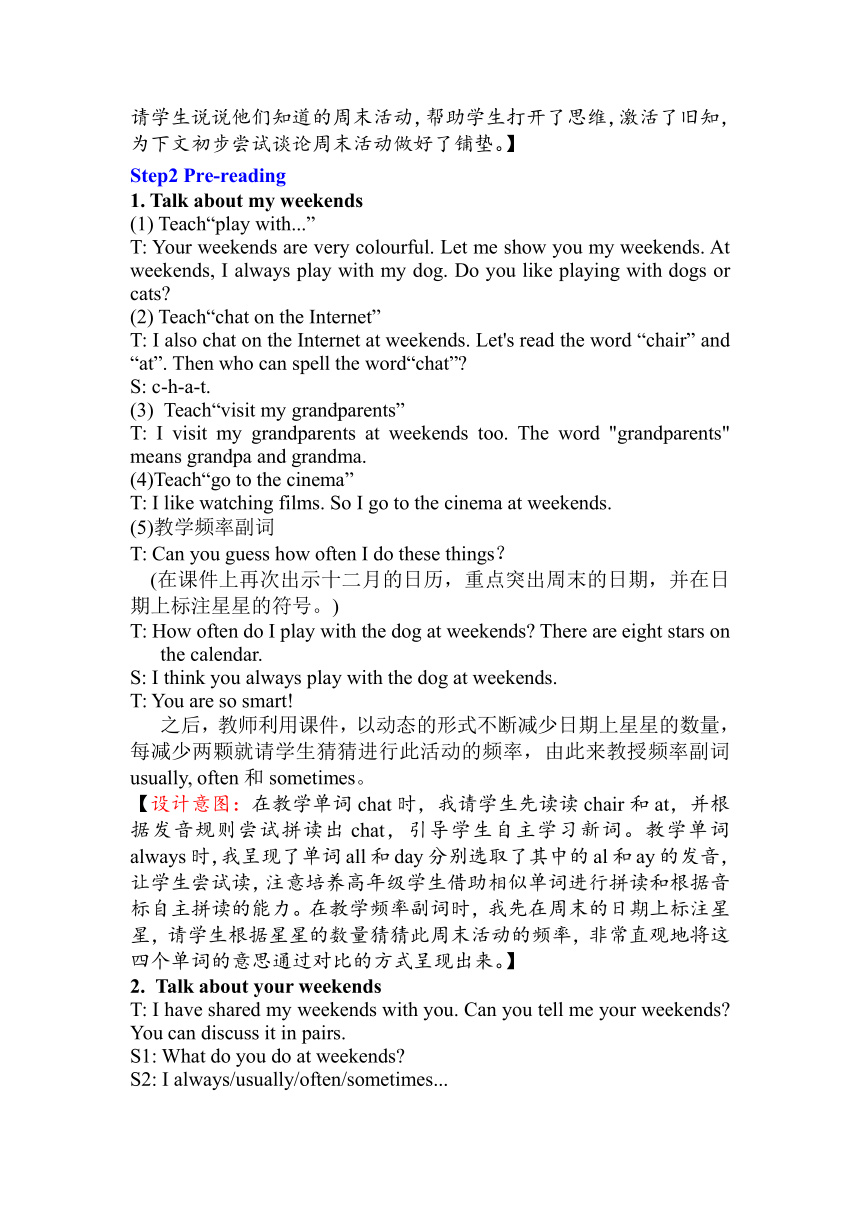Unit 7 At weekends 第一课时 story time 教案
文档属性
| 名称 | Unit 7 At weekends 第一课时 story time 教案 |  | |
| 格式 | zip | ||
| 文件大小 | 81.4KB | ||
| 资源类型 | 教案 | ||
| 版本资源 | 牛津译林版 | ||
| 科目 | 英语 | ||
| 更新时间 | 2021-11-26 16:51:05 | ||
图片预览



文档简介
Unit 7 At weekends 第一课时(story time)教学设计
一、教学内容
本节课的教学内容是译林版《英语》五年级上册Unit 7 At weekends的Story time板块。故事讲述了Mike和Su Hai在学校互相询问对方及其家人的周末活动。本节课涉及的主要句型有:What do you do at weekends I always/usually/ often/sometimes…教师通过介绍自己的周末活动,并以一个月周末活动的不同天数让学生明白频率副词的概念,引导学生说说他们的周末安排,再来了解文本故事中四位主人公的周末活动。在学习语篇的过程中,实行分段教学,帮助学生掌握一定的阅读技巧,并学会提问,最后能根据关键词,以第一人称的形式进行复述和介绍课文人物的活动。
二、教学目标:
1.知识目标
(1) 能听懂、会读、会说单词: weekends, grandparent, chat, Internet, cinema, always, usually, often, sometimes
(2) 能听懂、会读、会说句型: What do you do at weekends I always/usually/ often/sometimes…
2.能力目标
(1)能流利、有感情地朗读课文。
(2)能尝试复述课文人物的周末活动,体验人物周末活动的乐趣。
(3)能尝试运用本课所学的词汇和句型谈论自己的周末活动。
3.情感目标
能学会关心朋友,并合理安排好自己的周末活动,丰富活动内容。
三、教学重难点
1.教学重点
(1)能听懂、会读、会说单词: grandparent, chat, Internet, cinema, visit, always, usually, often, sometimes
(2)能正确朗读并理解故事
2.教学难点
(1)能理解并初步掌握频率副词的用法
(2)能介绍课文中人物的周末活动,并展开想象,进行适当的补充。
四、教法和学法分析
本课以开放式教学为主,教师在整个教学活动中都处于一个引导者、组织者与合作者的位置。把学生当作是学习的主体,努力创设平等、和谐的学习氛围,着力体现“以学生的发展为本”的教育理念,引导学生主动学习。教师通过教授学习方法,结合听、说、读、写的形式,培养学生自主学习词汇,理解语篇的能力,从而激发学生的思维。在教学文本时,逐层深入,帮助学生掌握一定的阅读技巧和学习方法,引导学生自主学习,积极思考,最后将接受到的信息内化为自己的语言。
五、教具准备
(1)打印的单词卡片
(2)课堂练习一张
(3)多媒体课件
六、教学过程
Step1 Warm up and lead in
Say a rhyme
T: At first, let's chant together. Please pay attention to the last letters.
Next to the window,
There is a horse.
It likes the cake,
It reads the book.
Give it the juice,
It has much fun.
Then flies a bird,
They are good friends.
T: They can make a word. What is it
S: Weekends.
2. 揭示课题 At Weekends
T: Yes! They can make the word "weekends". Let's look at the calendar of December. Saturdays and Sundays are weekends.
T: So today we will learn “Unit7 At Weekends”
3. Brain storming
T: We do many different things at weekends. Can you tell me any weekend activities (教师用课件呈现下图中的关键词,帮助学生回忆和表达)
S: play football/basketball/table tennis/the piano...
have a picnic/ have a big lunch/ have drawing lessons…
go skating/climbing/swimming/fishing
read stories/ watch TV/ do my homework
【设计意图:在热身环节,我出示了一首小诗,请学生观察每一行小诗的末尾部分的字母分别是什么?正是这些字母组成了课题weekends。为了便于学生理解此单词的含义,我出示了十二月的日历,请学生观察,每周六和周日加起来便为周末,再利用头脑风暴的形式请学生说说他们知道的周末活动,帮助学生打开了思维,激活了旧知,为下文初步尝试谈论周末活动做好了铺垫。】
Step2 Pre-reading
1. Talk about my weekends
(1) Teach“play with...”
T: Your weekends are very colourful. Let me show you my weekends. At weekends, I always play with my dog. Do you like playing with dogs or cats
(2) Teach“chat on the Internet”
T: I also chat on the Internet at weekends. Let's read the word “chair” and “at”. Then who can spell the word“chat”
S: c-h-a-t.
Teach“visit my grandparents”
T: I visit my grandparents at weekends too. The word "grandparents" means grandpa and grandma.
(4)Teach“go to the cinema”
T: I like watching films. So I go to the cinema at weekends.
(5)教学频率副词
T: Can you guess how often I do these things?
(在课件上再次出示十二月的日历,重点突出周末的日期,并在日期上标注星星的符号。)
T: How often do I play with the dog at weekends There are eight stars on the calendar.
S: I think you always play with the dog at weekends.
T: You are so smart!
之后,教师利用课件,以动态的形式不断减少日期上星星的数量,每减少两颗就请学生猜猜进行此活动的频率,由此来教授频率副词usually, often和sometimes。
【设计意图:在教学单词chat时,我请学生先读读chair和at,并根据发音规则尝试拼读出chat,引导学生自主学习新词。教学单词always时,我呈现了单词all和day分别选取了其中的al和ay的发音,让学生尝试读,注意培养高年级学生借助相似单词进行拼读和根据音标自主拼读的能力。在教学频率副词时,我先在周末的日期上标注星星,请学生根据星星的数量猜猜此周末活动的频率,非常直观地将这四个单词的意思通过对比的方式呈现出来。】
Talk about your weekends
T: I have shared my weekends with you. Can you tell me your weekends You can discuss it in pairs.
S1: What do you do at weekends
S2: I always/usually/often/sometimes...
【设计意图:在之前的环节进行了一定的词汇积累之后,请学生将新学的周末活动短语与旧知相结合,通过师生示范,小组讨论合作的方式,引导学生恰当地使用频率副词,自主谈论自己的周末活动。】
Step 3 While-reading
1. Watch and answer
T: Well done! I think your weekends are colourful. Su Hai and Mike are also talking about the weekends. Whose weekends are they talking about Let's watch the cartoon and find it.
S: Their and their friends' weekends.
T: Who are their friends in the story?
S:Su Yang and Helen.
【设计意图:通过完成观看卡通找答案的任务,一方面激发起学生的学习兴趣,调动了学习积极性;另一方面,学生在愉快的氛围中找到了答案,对故事有了整体感知,可谓一举两得。】
2. Learn Su Hai and Su Yang’s weekends after the teacher
T: At first, let’s learn Su Hai and Su Yang’s weekends in details.
(1)Read and underline their weekend activities
T: What do Su Hai and Su Yang do at weekends
S: visit her grandparents/play with their cat kitty/have dinner with their grandparents
(2)Circle the frequency adverbs
T: What are the frequency adverbs
S: usually/often.
Learn Mike's and Helen's weekends in pairs
T: After learning Su Hai and Su Yang’s weekends, what about Helen’s and Mike’s weekends
(教师将学生分为两大组,请单数小组的学生自读麦克的周末活动,双数小组的学生自读海伦的周末活动,读完之后同桌互相问答,了解对方的学习内容。在课件上出示自主学习方法的小贴士:第一步,先划出周末活动的短语,再圈出频率副词。第二步,同桌问答,合作学习,填写答案。)
T: After reading it, please ask your partners some questions and write them down.
T: We all have finished the first step. Let’s move to the step two and look at some questions about their weekends.
T: Does Mike care about his grandparents?
S1: Yes, he does.
T: We should care about our family too.
T: Does Helen make her weekends colourful?
S2: Yes, she does.
T: We can also make our weekends colourful.
T: Can you ask any other questions
S: Do Mike and Liu Tao play football at weekends
...
【设计意图:在获取了故事大意之后,学生对人物周末活动的感受还不是很深,于是我将整个故事细化为三部分进行教学,第一部分是苏海和苏阳的周末活动,我先请学生划出她们的周末活动,圈出频率副词,起到了示范的作用。接着,就将学生分成单数小组和双数小组,分别自读第二、三部分麦克和海伦的周末活动,并在阅读完自己的部分之后,提问同桌所阅读的部分进行问答,考察理解的程度。与此同时,对自学有余力的同学还可以提出新的问题,问问其他同学,鼓励学生积极地思考。在设计问题时,我还注意引导学生像故事中的主人公进行学习,学会关心家人和朋友,合理安排丰富自己的周末活动,使周末生活丰富多彩。】
Reading time
T: Now it's time to read. Let's read and imitate after the tape. Please pay attention to the intonation.
Choose one way to read and act
【设计意图:小学生喜爱表演和模仿,为此我设计了一个跟读环节,在模仿跟读时,请学生注意录音中的升调,降调,重读,帮助他们树立学习英语的自信心,也为之后的展示环节奠定了基础。】
Step4 Post-reading
1. Talk and say
T: After reading the story, can you choose one role to introduce his or her weekends in your word Please add some information. You can discuss in group of two.
T: Hello! I 'm Helen! I always have dancing lessons at weekends. I like dancing very much.(自主补充) I sometimes go to the cinema with my friends. The films are very funny.(展开想象)
【设计意图:在最后的巩固环节,学生根据板书,结合自己本堂课所学,整合信息,适时地进行补充,并展开合理的想象,自主介绍文本中人物的周末活动。】
2. Enjoy some pictures.
欣赏一些国外学生周末活动的图片
3.情感升华
Plan your study well and enjoy your weekends as well!
安排好学习,享受好周末!
【设计意图:在本课的学习过程中,始终穿插着情感教育,通过欣赏一些图片,让学生明白什么样的周末才是丰富多彩的,不要沉迷于电脑和手机游戏之中,要合理安排好学习,享受好周末,可谓是课尾的一个升华。】
Step5 Homework
1. Read the story after the tape.跟读录音并能流利地朗读课文。
2. Share your weekends with friends. 和朋友分享你的周末活动。
【设计意图:语言学习的最终目的是输出。让学生尝试去了解朋友在周末的活动,分享节日的快乐,是学生愿意做的事情,也是学生通过本课学习能够做的事情。这个活动的设计为下节课活动板块的教学做好了衔接和铺垫。】
Step 6 Blackboard design
Unit 7 At weekends
What do you do at weekends
I always/usually/ often/sometimes…
always usually often sometimes
visit our grandparents have dinner
chat on the Internet go to the park
play football
fly a kite
have a picnic
have dancing lessons go to the cinema
【设计意图:本课主要讲述了Su Hai、Su Yang、Mike和Helen的周末活动,此板书能很清晰的显示出来,而且头像和各活动进行的频率相对应起来,降低了理解的难度。对学生在读后环节,复述人物的周末活动中帮助很大。】
一、教学内容
本节课的教学内容是译林版《英语》五年级上册Unit 7 At weekends的Story time板块。故事讲述了Mike和Su Hai在学校互相询问对方及其家人的周末活动。本节课涉及的主要句型有:What do you do at weekends I always/usually/ often/sometimes…教师通过介绍自己的周末活动,并以一个月周末活动的不同天数让学生明白频率副词的概念,引导学生说说他们的周末安排,再来了解文本故事中四位主人公的周末活动。在学习语篇的过程中,实行分段教学,帮助学生掌握一定的阅读技巧,并学会提问,最后能根据关键词,以第一人称的形式进行复述和介绍课文人物的活动。
二、教学目标:
1.知识目标
(1) 能听懂、会读、会说单词: weekends, grandparent, chat, Internet, cinema, always, usually, often, sometimes
(2) 能听懂、会读、会说句型: What do you do at weekends I always/usually/ often/sometimes…
2.能力目标
(1)能流利、有感情地朗读课文。
(2)能尝试复述课文人物的周末活动,体验人物周末活动的乐趣。
(3)能尝试运用本课所学的词汇和句型谈论自己的周末活动。
3.情感目标
能学会关心朋友,并合理安排好自己的周末活动,丰富活动内容。
三、教学重难点
1.教学重点
(1)能听懂、会读、会说单词: grandparent, chat, Internet, cinema, visit, always, usually, often, sometimes
(2)能正确朗读并理解故事
2.教学难点
(1)能理解并初步掌握频率副词的用法
(2)能介绍课文中人物的周末活动,并展开想象,进行适当的补充。
四、教法和学法分析
本课以开放式教学为主,教师在整个教学活动中都处于一个引导者、组织者与合作者的位置。把学生当作是学习的主体,努力创设平等、和谐的学习氛围,着力体现“以学生的发展为本”的教育理念,引导学生主动学习。教师通过教授学习方法,结合听、说、读、写的形式,培养学生自主学习词汇,理解语篇的能力,从而激发学生的思维。在教学文本时,逐层深入,帮助学生掌握一定的阅读技巧和学习方法,引导学生自主学习,积极思考,最后将接受到的信息内化为自己的语言。
五、教具准备
(1)打印的单词卡片
(2)课堂练习一张
(3)多媒体课件
六、教学过程
Step1 Warm up and lead in
Say a rhyme
T: At first, let's chant together. Please pay attention to the last letters.
Next to the window,
There is a horse.
It likes the cake,
It reads the book.
Give it the juice,
It has much fun.
Then flies a bird,
They are good friends.
T: They can make a word. What is it
S: Weekends.
2. 揭示课题 At Weekends
T: Yes! They can make the word "weekends". Let's look at the calendar of December. Saturdays and Sundays are weekends.
T: So today we will learn “Unit7 At Weekends”
3. Brain storming
T: We do many different things at weekends. Can you tell me any weekend activities (教师用课件呈现下图中的关键词,帮助学生回忆和表达)
S: play football/basketball/table tennis/the piano...
have a picnic/ have a big lunch/ have drawing lessons…
go skating/climbing/swimming/fishing
read stories/ watch TV/ do my homework
【设计意图:在热身环节,我出示了一首小诗,请学生观察每一行小诗的末尾部分的字母分别是什么?正是这些字母组成了课题weekends。为了便于学生理解此单词的含义,我出示了十二月的日历,请学生观察,每周六和周日加起来便为周末,再利用头脑风暴的形式请学生说说他们知道的周末活动,帮助学生打开了思维,激活了旧知,为下文初步尝试谈论周末活动做好了铺垫。】
Step2 Pre-reading
1. Talk about my weekends
(1) Teach“play with...”
T: Your weekends are very colourful. Let me show you my weekends. At weekends, I always play with my dog. Do you like playing with dogs or cats
(2) Teach“chat on the Internet”
T: I also chat on the Internet at weekends. Let's read the word “chair” and “at”. Then who can spell the word“chat”
S: c-h-a-t.
Teach“visit my grandparents”
T: I visit my grandparents at weekends too. The word "grandparents" means grandpa and grandma.
(4)Teach“go to the cinema”
T: I like watching films. So I go to the cinema at weekends.
(5)教学频率副词
T: Can you guess how often I do these things?
(在课件上再次出示十二月的日历,重点突出周末的日期,并在日期上标注星星的符号。)
T: How often do I play with the dog at weekends There are eight stars on the calendar.
S: I think you always play with the dog at weekends.
T: You are so smart!
之后,教师利用课件,以动态的形式不断减少日期上星星的数量,每减少两颗就请学生猜猜进行此活动的频率,由此来教授频率副词usually, often和sometimes。
【设计意图:在教学单词chat时,我请学生先读读chair和at,并根据发音规则尝试拼读出chat,引导学生自主学习新词。教学单词always时,我呈现了单词all和day分别选取了其中的al和ay的发音,让学生尝试读,注意培养高年级学生借助相似单词进行拼读和根据音标自主拼读的能力。在教学频率副词时,我先在周末的日期上标注星星,请学生根据星星的数量猜猜此周末活动的频率,非常直观地将这四个单词的意思通过对比的方式呈现出来。】
Talk about your weekends
T: I have shared my weekends with you. Can you tell me your weekends You can discuss it in pairs.
S1: What do you do at weekends
S2: I always/usually/often/sometimes...
【设计意图:在之前的环节进行了一定的词汇积累之后,请学生将新学的周末活动短语与旧知相结合,通过师生示范,小组讨论合作的方式,引导学生恰当地使用频率副词,自主谈论自己的周末活动。】
Step 3 While-reading
1. Watch and answer
T: Well done! I think your weekends are colourful. Su Hai and Mike are also talking about the weekends. Whose weekends are they talking about Let's watch the cartoon and find it.
S: Their and their friends' weekends.
T: Who are their friends in the story?
S:Su Yang and Helen.
【设计意图:通过完成观看卡通找答案的任务,一方面激发起学生的学习兴趣,调动了学习积极性;另一方面,学生在愉快的氛围中找到了答案,对故事有了整体感知,可谓一举两得。】
2. Learn Su Hai and Su Yang’s weekends after the teacher
T: At first, let’s learn Su Hai and Su Yang’s weekends in details.
(1)Read and underline their weekend activities
T: What do Su Hai and Su Yang do at weekends
S: visit her grandparents/play with their cat kitty/have dinner with their grandparents
(2)Circle the frequency adverbs
T: What are the frequency adverbs
S: usually/often.
Learn Mike's and Helen's weekends in pairs
T: After learning Su Hai and Su Yang’s weekends, what about Helen’s and Mike’s weekends
(教师将学生分为两大组,请单数小组的学生自读麦克的周末活动,双数小组的学生自读海伦的周末活动,读完之后同桌互相问答,了解对方的学习内容。在课件上出示自主学习方法的小贴士:第一步,先划出周末活动的短语,再圈出频率副词。第二步,同桌问答,合作学习,填写答案。)
T: After reading it, please ask your partners some questions and write them down.
T: We all have finished the first step. Let’s move to the step two and look at some questions about their weekends.
T: Does Mike care about his grandparents?
S1: Yes, he does.
T: We should care about our family too.
T: Does Helen make her weekends colourful?
S2: Yes, she does.
T: We can also make our weekends colourful.
T: Can you ask any other questions
S: Do Mike and Liu Tao play football at weekends
...
【设计意图:在获取了故事大意之后,学生对人物周末活动的感受还不是很深,于是我将整个故事细化为三部分进行教学,第一部分是苏海和苏阳的周末活动,我先请学生划出她们的周末活动,圈出频率副词,起到了示范的作用。接着,就将学生分成单数小组和双数小组,分别自读第二、三部分麦克和海伦的周末活动,并在阅读完自己的部分之后,提问同桌所阅读的部分进行问答,考察理解的程度。与此同时,对自学有余力的同学还可以提出新的问题,问问其他同学,鼓励学生积极地思考。在设计问题时,我还注意引导学生像故事中的主人公进行学习,学会关心家人和朋友,合理安排丰富自己的周末活动,使周末生活丰富多彩。】
Reading time
T: Now it's time to read. Let's read and imitate after the tape. Please pay attention to the intonation.
Choose one way to read and act
【设计意图:小学生喜爱表演和模仿,为此我设计了一个跟读环节,在模仿跟读时,请学生注意录音中的升调,降调,重读,帮助他们树立学习英语的自信心,也为之后的展示环节奠定了基础。】
Step4 Post-reading
1. Talk and say
T: After reading the story, can you choose one role to introduce his or her weekends in your word Please add some information. You can discuss in group of two.
T: Hello! I 'm Helen! I always have dancing lessons at weekends. I like dancing very much.(自主补充) I sometimes go to the cinema with my friends. The films are very funny.(展开想象)
【设计意图:在最后的巩固环节,学生根据板书,结合自己本堂课所学,整合信息,适时地进行补充,并展开合理的想象,自主介绍文本中人物的周末活动。】
2. Enjoy some pictures.
欣赏一些国外学生周末活动的图片
3.情感升华
Plan your study well and enjoy your weekends as well!
安排好学习,享受好周末!
【设计意图:在本课的学习过程中,始终穿插着情感教育,通过欣赏一些图片,让学生明白什么样的周末才是丰富多彩的,不要沉迷于电脑和手机游戏之中,要合理安排好学习,享受好周末,可谓是课尾的一个升华。】
Step5 Homework
1. Read the story after the tape.跟读录音并能流利地朗读课文。
2. Share your weekends with friends. 和朋友分享你的周末活动。
【设计意图:语言学习的最终目的是输出。让学生尝试去了解朋友在周末的活动,分享节日的快乐,是学生愿意做的事情,也是学生通过本课学习能够做的事情。这个活动的设计为下节课活动板块的教学做好了衔接和铺垫。】
Step 6 Blackboard design
Unit 7 At weekends
What do you do at weekends
I always/usually/ often/sometimes…
always usually often sometimes
visit our grandparents have dinner
chat on the Internet go to the park
play football
fly a kite
have a picnic
have dancing lessons go to the cinema
【设计意图:本课主要讲述了Su Hai、Su Yang、Mike和Helen的周末活动,此板书能很清晰的显示出来,而且头像和各活动进行的频率相对应起来,降低了理解的难度。对学生在读后环节,复述人物的周末活动中帮助很大。】
